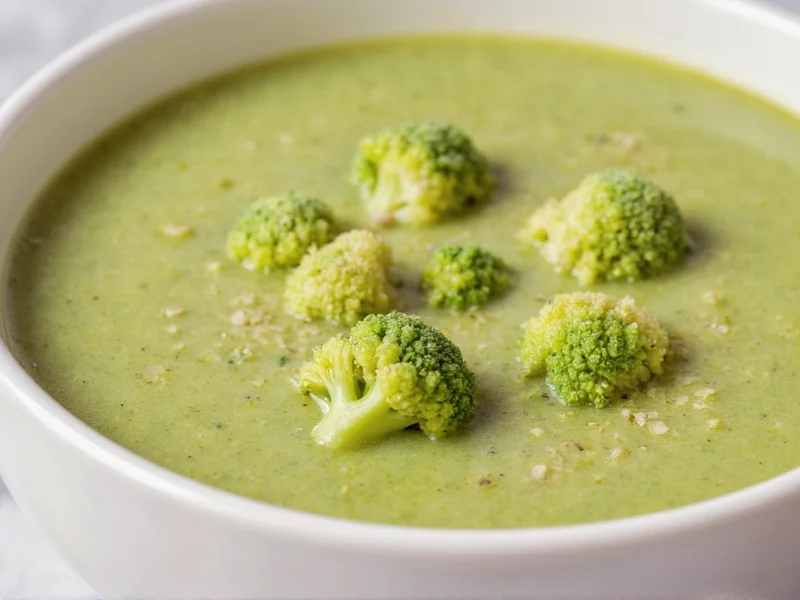Cream of broccoli soup stands as one of the most versatile comfort foods, combining nutritional benefits with rich flavor in a single bowl. What separates an ordinary version from an exceptional one lies in technique rather than complexity—properly cooking the broccoli to preserve its vibrant color and fresh taste while achieving that signature silky texture without relying on excessive cream or thickeners.
The Science Behind Perfect Cream of Broccoli Soup
Understanding the culinary principles transforms this simple soup from bland to brilliant. Broccoli contains sulfur compounds that can turn bitter when overcooked, while the emulsification process determines whether your soup will be velvety or grainy. The secret? Blanching broccoli briefly before pureeing preserves both color and flavor, while incorporating warm liquid gradually into the blender prevents separation.
Essential Ingredients for Superior Flavor
The quality of your ingredients directly impacts the final result. While basic recipes exist, professional kitchens achieve depth through strategic ingredient selection:
| Ingredient | Professional Selection Tip | Avoid |
|---|---|---|
| Broccoli | Choose deep green florets with tight buds; stems contain more fiber and less bitterness | Yellowing florets or woody stems |
| Base Liquid | Homemade vegetable broth for depth; unsweetened almond milk for dairy-free creaminess | Canned broth with artificial flavors |
| Thickener | Riced cauliflower or soaked cashews for natural thickness | Flour roux (creates gluey texture) |
| Flavor Enhancers | Lemon zest, garlic confit, white miso paste | Excessive salt or artificial seasonings |
Step-by-Step Preparation Guide
- Prep broccoli properly: Separate florets from stems. Peel and dice stems (they cook slower), blanch stems for 2 minutes before adding florets for 90 seconds. Shock in ice water to preserve color.
- Build flavor foundation: Sauté diced shallot in olive oil until translucent. Add minced garlic and a pinch of nutmeg, cooking just until fragrant (30 seconds).
- Combine ingredients: Add blanched broccoli, 2 cups vegetable broth, and 1/2 cup raw cauliflower rice to pot. Simmer 15 minutes until broccoli is fork-tender.
- Blend to perfection: Transfer mixture to high-speed blender. With blender running, slowly stream in 1/2 cup warm unsweetened almond milk through lid opening. Blend 60 seconds until completely smooth.
- Final seasoning: Return to pot, stir in lemon zest and 1 tsp white miso paste. Adjust salt only after miso addition (it contains salt).
Pro Techniques for Restaurant-Quality Results
Home cooks often miss these critical details that elevate cream of broccoli soup from acceptable to extraordinary:
- Temperature control during blending: Hot soup expands in blenders, creating dangerous pressure. Always fill blender no more than halfway and remove the center cap, covering with a towel to allow steam to escape safely.
- Color preservation trick: The brief ice bath after blanching stops enzymatic browning. For even brighter results, add 1/4 tsp baking soda to blanching water (use sparingly to avoid flavor changes).
- Texture refinement: Strain through a fine-mesh sieve after blending for ultra-smooth texture, pressing with a ladle rather than stirring to avoid incorporating air bubbles.
- Flavor balancing: If soup tastes too vegetal, add 1/8 tsp citric acid or a squeeze of lemon. If too thin, simmer uncovered for 5 minutes rather than adding thickeners.
Variations for Dietary Needs
This adaptable recipe accommodates various dietary requirements without sacrificing quality:
- Dairy-free cream of broccoli soup: Substitute almond milk with coconut milk (use light version to avoid overpowering flavor) and add 1 tbsp nutritional yeast for umami depth.
- Low-carb version: Replace cauliflower rice with 1/4 cup raw sunflower seeds, soaked for 2 hours, which provide creaminess without starch.
- Protein boost: Stir in 1/2 cup white beans after blending for added protein and fiber without altering flavor profile.
- Smoky variation: Add 1/4 tsp smoked paprika and finish with a drizzle of roasted garlic oil for complex flavor without heaviness.
Storage and Reheating Best Practices
Proper storage maintains both safety and quality:
- Cool soup completely within 2 hours of cooking (divide into shallow containers to speed cooling)
- Store in airtight containers for up to 4 days in refrigerator
- Freeze in portion-sized containers for up to 3 months (leave 1-inch headspace for expansion)
- Reheat gently over medium-low heat, adding splashes of broth if separation occurs
- Never microwave frozen soup directly—thaw overnight in refrigerator first
Troubleshooting Common Issues
Address these frequent problems with professional solutions:
- Grainy texture: Caused by undercooked broccoli or insufficient blending. Solution: Return to pot and simmer 5 more minutes, then blend again with 2 tbsp warm liquid.
- Brownish color: Results from overcooking or enzymatic browning. Solution: Always blanch in salted boiling water with ice bath finish.
- Watery consistency: Don't add thickeners—simmer uncovered for 8-10 minutes to reduce naturally.
- Bitter taste: Caused by overcooked broccoli or using yellowing florets. Solution: Balance with 1/4 tsp citric acid and 1 tsp maple syrup.
Why This Recipe Outperforms Canned Versions
Homemade cream of broccoli soup offers significant advantages over store-bought alternatives. Commercial versions typically contain preservatives, artificial flavors, and excessive sodium to extend shelf life. A single serving of canned soup often contains 800-1000mg sodium—nearly half the recommended daily intake. By preparing your own, you control ingredients, avoid unnecessary additives, and preserve the vegetable's natural nutrients that get degraded during commercial processing. The fresh flavor and vibrant color simply can't be replicated in canned products.











 浙公网安备
33010002000092号
浙公网安备
33010002000092号 浙B2-20120091-4
浙B2-20120091-4